Pickup trucks are gas guzzlers. Perhaps.
Thanks to fuel efficiency technology improvements, pickup trucks like the Ford F-150 or the Chevy Silverado 1500 are getting reasonably good mileage off the lot these days.
Truck ownership has expanded to the masses beyond it’s rural applications.
That means, the addressable market for truck owners is growing. In turn, increasing truck part retailers to increase sales.
Truck diesel parts PPC target market
PPC campaigns for truck parts and performance upgrade parts can be complex.
You have to take into account the year, make, and model. On top of that, there are specific ad copy to tackle. And a lot of there ad copy nuances that are unique to auto parts PPC marketing.
A PPC campaign that started with a handful of ads could end up with hundreds of unique ad copy after aggressive keyword expansion.
In this article, I will focus on PPC strategies for diesel truck performance parts across search and social.
I’m choosing a singular category within the auto parts industry so we can go in detail what you should and can be doing to uncover opportunities and scale your PPC campaigns.
We’re going to get specific in this article. So buckle up. It’s going to be one hell of a ride!
Chevy Silverado cold air intakes
So I stay focused on my article’s objective, I will use the Chevrolet Silverado cold air intake systems for this purpose.
Want to sell more chevy silverado cold air intakes? Good. This article is just what you’re looking for.
I will go over the ToFu, MoFu, and BoFu. This format is a time-tested structure that introduce, engages, then convert customers.
As a reference,
- ToFu = Top of Funnel (cold audience)
- MoFu = Mid of Funnel (engaged audience)
- BoFu = Bottom of Funnel (customers)
Top funnel targeting for cold audience
The mistake many auto parts business make is to go for the sale in every ad.
Yes, you will get some sales when you start going for the quick sale. But you won’t realize the maximum potential of your campaign.
The first step is to define your audience you want to introduce your brand to. Your ad content for this audience should create value for the Chevy Silverado truck owners.
In Facebook, you can start by defining your audiences based on interest.
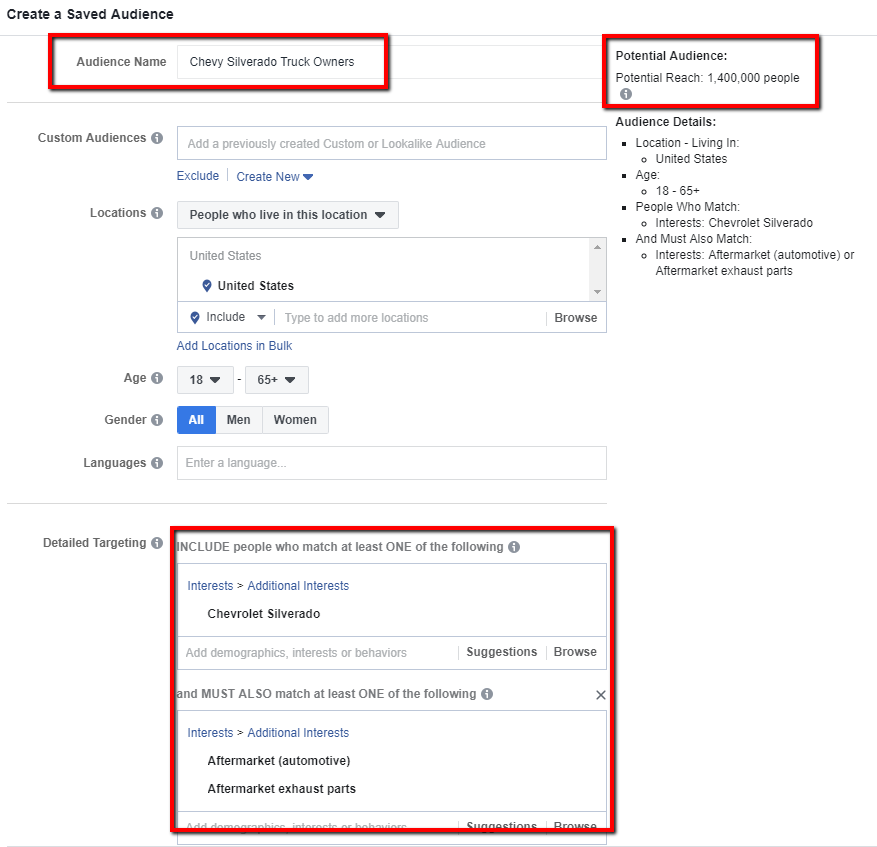
Because this is the ToFu audience, don’t try to be too specific. Start with the most obvious and basic targeting.
I’m not even targeting any specific states or cities for this audience.
Start by defining people who are Chevrolet Silverado owners and have interests in aftermarket parts.
This might seem too broad, but remember your objective. You are going after as many people as you can to create value – not sell.
I recommend creating 2 to 3 more audiences with different targeting, while keeping the Chevrolet Silverado as the primary.
You could create audience to target:
- auto shows
- pickup trucks
- auto parts
- auto racing
Pro tip: put in the extra work to create ad images, videos, or slideshows that align with each audience interest group.
If you are advertising to Chevrolet Silverado owners who are also interested in auto racing, then your creative asset should create an emotional connection to inspire. This might include performance improvements, statistics…you know, the number stuff that an auto-racing Chevy Silverado owner might care about.
As deep as you can go within Facebook’s audience targeting, it is still limited to Facebook and Instagram.
That means you’ll have also create audience in Google to reach Chevy Silverado truck owners across Google’s search network.
Create a Google Custom Affinity Audience
As with your Facebook audience, I recommend being specific in what you name your audience. It’ll be a lot easier to manage it when you launch your ToFu campaign.
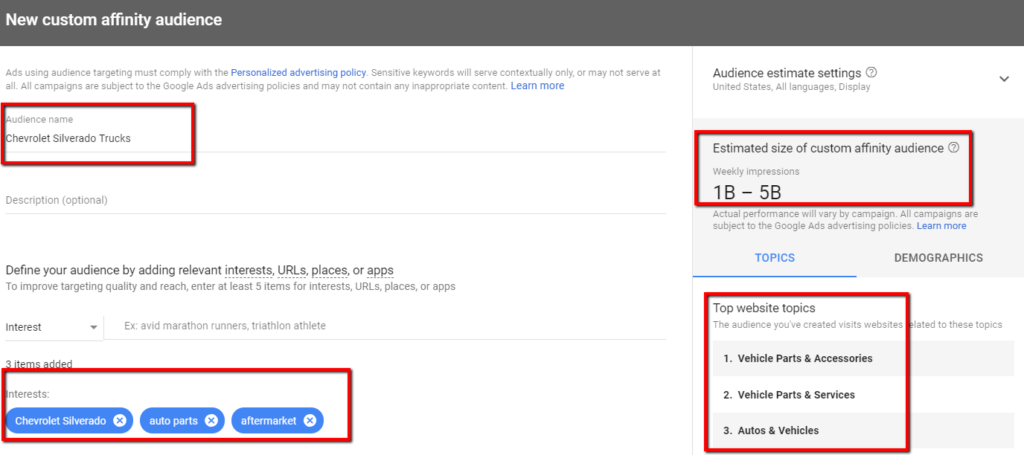
When building your Google affinity audience, you can define your targeting based on interest, URLs, places, or apps.
In our example, I’ve entered “Chevrolet Silverado,” “auto parts,” and “aftermarket” as my interest parameters.
I don’t think there’s close to 1 billion addressable Chevrolet Silverado truck owners, so take that with a grain of salt.
What is more interesting is the matching of website topics — giving me a vote of confidence in my audience definition criteria selection.
Once you have built this Google affinity audience for Chevy Silverado pickup trucks, you can include this audience in your ToFu campaign.
Now you have two defined audiences — Facebook and Google — that you can target your cold audience with.
You should not expect this campaign to have many direction conversions. However, you can anticipate a lot of relevant traffic to be driven to your website.
That brings us to the MoFu audience
Let’s say your ToFu cold audience campaign is working like a charm and driving a ton of new Chevy Silverado truck owners to your website.
But alas, barely anyone bought a new diesel part for their vehicle.
That’s OK, it was anticipated.
When both Google and Facebook pixel on your website, you can create your next audience groups based on the visitors’ actions.
The people in this audience are people who are now aware of your brand, website, and products.
In Facebook, you can create new custom audiences. Here are a few common audiences:
- people who visited your Chevy Silverado diesel parts page,
- added a part to their cart but did not purchase,
- viewed certain product categories for the Chevy Silverado truck,
- and much more.
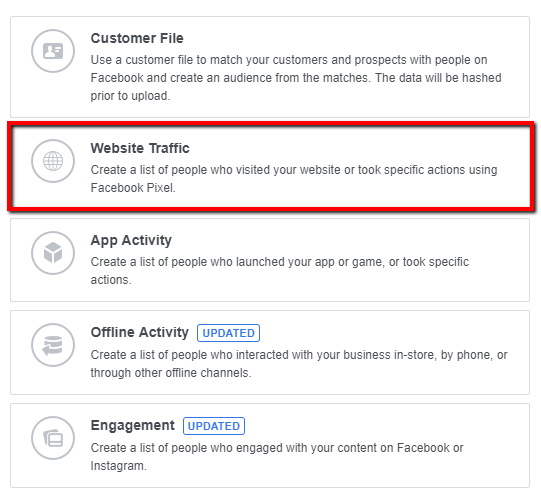
If you sent the ToFu cold audience to a specific page on your website, then you can create a custom audience of people who visited that specific web page.
Based on the action your visitors took, now that you have their attention, you can retarget them with more specific ad creative to showcase your products more deliberately.

Excluding visitors is just as powerful as inclusions.

It is just as important to make sure your BoFu campaign is not wasting marketing spend on visitors who are unlikely to become customers in the BoFu campaign.
Therefore, consider building audiences that fall out of your desired action that you can exclude in your campaign targeting.
Here are a list of actions you can consider excluding:
- visits to other pages that’s not about Chevy Silverado parts,
- people who ended up purchasing at this stage of the funnel,
- viewed products that are not cold air intakes ,
- people who left the site within seconds (non-engagers),
- and many more.
In addition to website actions, you can also create audience segments based on your Facebook pixel events like searches, adding to carts, page views, wishlist, purchases, and more.
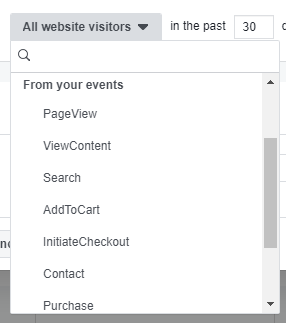
As you can imagine, the more specific you define your audience, the better your MoFu Facebook campaign can be.
Building MoFu audiences for Google campaign is different.
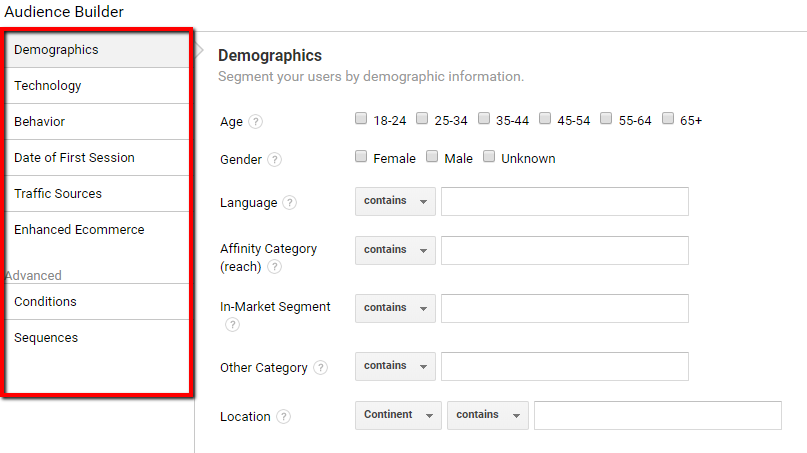
You can an endless group of audiences within your Google Analytics.
Unlike Facebook, where all your data is within the Facebook interface, in order for you to launch a MoFu Google Ads campaign requires you to leverage your Google analytics data.
Building audience is powerful in Google Analytics. Why? Because Google Analytics track every action, activity, behavior, devices, and transaction, you can create the most relevant audiences for your Google Ads campaign.
Retargeting Facebook visitors with Google audiences.
Let’s face it. The same Chevy Silverado truck owner who spends time on Facebook will also search for truck parts on Google.
You could be targeting your ToFu cold audience on Facebook, then building an audience in Google Analytics of Facebook visitors that you can retarget through Google Ads. That’s powerful.
This is precisely why you should execute on a multi-channel ad campaign to reach your prospects across search and social — it’s no longer a luxury, rather a necessity.
Your middle of funnel campaigns is designed to continue reinforcing how your product will add more value to the Chevy Silverado truck owners.
Your ad creative and messaging show how much more horsepower and power they can gain from your cold air intake, flow more cool, dense air for greater power & fuel economy.
Unlike your ToFu ads, that is created to introduce your brand and tell your story, the MoFu ads are designed to demonstrate how your product can make unleash the power of their Chevy Silverado trucks.
Execute your BoFu to close the sale
The ads for bottom of funnel is where the rubber meets the road.
So far, your ads might have skewed on the generic side — more branded imagery and categorical ad copy.
Consequently, the BoFu ad creatives and messaging will have your strongest Call-to-Action, specific Silverado models, trims, etc.
Here are a few elements to pay special attention to in your bottom of funnel money-making ads.
- text ad headlines – using the specifics. Is it a Crew Cab, Double Cab, or Regular, etc.
- using the year of the model – this can be achieved using dynamic product ads rather than manually creating ad headlines for evey year
- advertising any offers if available
- using ad extensions to add more unique value proposition to your ads
- tiered retargeting to increase the offer
- and many more.
Keep in mind, your BoFu audience are Silverado owners who are already know your business, engage with your content and have the highest likelihood of buying from you.
You just need to give them the right offer to close the sale.
Here are more PPC ad copy tips to get your more conversions.
Supercharging your PPC campaigns
PPC is not the only marketing channel when it comes to optimizing your audience funnel.
There’s still other channels that needs to be incorporated into the funnel — email, SEO, content marketing, chatbots, automation, etc.
While this focused on my favorite truck, the Chevy Silverado, you can apply this same approach to any other make and models you are selling auto parts for.
I hope this article has helped you.

